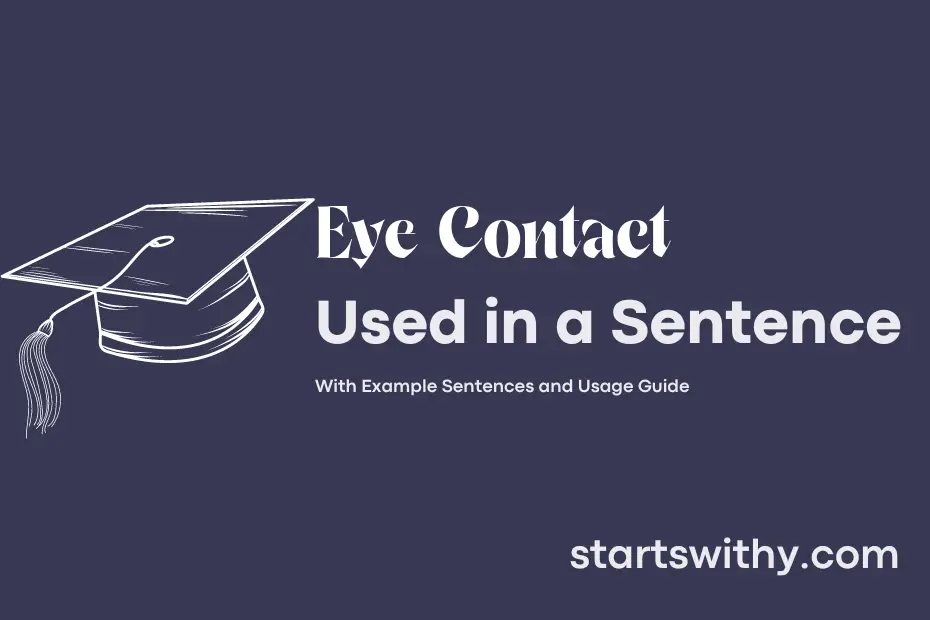Eye contact, a nonverbal form of communication, refers to the act of looking directly into another person’s eyes. This form of connection conveys messages, emotions, and intentions without the need for words. It is a powerful tool that plays a significant role in human interactions and relationships.
Several aspects of eye contact, such as the duration, intensity, and purpose, can greatly influence the dynamics of a conversation or interaction. It can signal interest, attentiveness, confidence, or even intimidation depending on the context. Understanding the nuances of eye contact can enhance communication skills and help individuals navigate social situations with greater insight and effectiveness.
7 Examples Of Eye Contact Used In a Sentence For Kids
- Make eye contact with your friends when you talk to them.
- Eye contact helps us show that we are listening.
- When playing a game, try to make eye contact with everyone.
- It’s important to make eye contact when saying hello or thank you.
- When you look someone in the eyes, it’s called making eye contact.
- Practice making eye contact and smiling when meeting new people.
- Remember to always make eye contact when speaking to your teacher.
14 Sentences with Eye Contact Examples
- Eye contact is important when you are giving a presentation in front of your classmates.
- During a job interview, make sure to maintain eye contact with the interviewer to show confidence.
- When asking a question to your professor, it is polite to make eye contact to convey respect.
- During group discussions, try to establish eye contact with each member to show active participation.
- Making eye contact with your friends while discussing a project can enhance communication and ideas exchange.
- In social settings, maintaining eye contact can help in building connections and forming relationships.
- While attending a seminar, making eye contact with the speaker indicates attentiveness.
- During networking events, remember to make eye contact to leave a positive impression.
- When seeking help from a senior, it’s essential to establish eye contact to show seriousness and engagement.
- In a debate competition, strong eye contact with the audience can make your arguments more persuasive.
- During a class discussion, maintaining eye contact with the professor shows interest and understanding of the topic.
- Engaging in eye contact during a group study session can foster collaboration and brainstorming.
- When meeting new people at college events, making eye contact can help in creating a memorable first impression.
- In team projects, regular eye contact helps in ensuring effective coordination and task allocation.
How To Use Eye Contact in Sentences?
Eye Contact is a powerful tool in communication that can convey confidence, sincerity, and interest. To effectively use eye contact in a sentence, focus on maintaining a balance between looking directly into the other person’s eyes and not staring too intensely.
Begin by establishing eye contact when initiating a conversation or when someone is speaking to you. This shows that you are actively engaged and interested in what they are saying. Avoid looking around the room or checking your phone, as this can signal disinterest.
During a conversation, remember to break eye contact occasionally to prevent it from becoming too intense or intimidating. A good rule of thumb is to maintain eye contact for a few seconds at a time before looking away briefly.
When speaking, try to hold eye contact with your audience to build rapport and convey your message more effectively. This shows confidence and helps to establish trust.
In a professional setting, eye contact is especially important during meetings, presentations, and networking events. It can make you appear more credible and assertive.
Overall, practicing good eye contact can enhance your communication skills and improve your relationships with others. Remember to be natural and authentic in your interactions, as eye contact is most effective when it reflects genuine interest and engagement.
Conclusion
In interpersonal communication, maintaining good eye contact plays a vital role in establishing a connection and conveying confidence and attentiveness. Effective eye contact fosters engagement and understanding between individuals, allowing for better communication and relationship building. For example, “She made sure to maintain eye contact throughout the meeting to show her interest and understanding,” illustrates how eye contact can enhance communication and demonstrate active listening.
When combined with other forms of nonverbal communication, such as nodding and smiling, eye contact can further strengthen the message being conveyed and create a more positive interaction. “He used strong eye contact and a warm smile to express his gratitude,” showcases the power of combining eye contact with facial expressions to convey emotions effectively. Therefore, harnessing the power of eye contact can greatly improve communication and relationships in various personal and professional settings.



